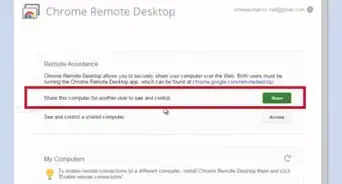This article was co-authored by Jesse Kuhlman. Jesse Kuhlman is a Master Electrician and the Owner of Kuhlman Electrician Services based in Massachusetts. Jesse specializes in all aspects of home/residential wiring, troubleshooting, generator installation, and WiFi thermostats. Jesse is also the author of four eBooks on home wiring including "Residential Electrical Troubleshooting" which covers basic electrical troubleshooting in residential homes.
There are 8 references cited in this article, which can be found at the bottom of the page.
This article has been viewed 26,673 times.
Joining an electrical union gives you the rights granted by a collective bargaining agreement, which means you and your fellow union members are able to bargain over wages, health benefits, working conditions, and a retirement plan. Your local union can also provide you with job opportunities and additional training. To join an electrician’s union, start by making sure you qualify and then look for a local union. Contact them, complete any required applications and paperwork, and pay your dues when you’re accepted to start taking advantage of the benefits and programs they provide.
Steps
Becoming a Member
-
1Be a licensed electrician or a journeyman electrician to join a union. In order to join an electrician’s union, you either need to already working as one or become a journeyman electrician by participating in an apprenticeship program. You’ll need to be able to provide your license number to join a local union. You can also contact a local union to sign up for their apprenticeship program and become a journeyman.[1]
- You can complete an electrical program at a trade school or community college to earn your license. Electrician programs generally take 4 years to complete when they also involve an apprenticeship program.
- You need to have a high school diploma or earn a GED before you apply to a trade school or an apprenticeship program.
- Make sure that you're put on payroll during your apprenticeship years. If you're working under a 1099 form, the hours might not count toward your license.
-
2Check the IBEW website for a local union if you’re in North America. The International Brotherhood of Electrical Workers, or the IBEW, is the largest organization of electrical workers in North America, and their website has resources you can use to locate a union in your area. Visit their website and search for a local union that you can join.[2]
- Go to http://www.ibew.org/Tools/Local-Union-Directory to search by province, state, or county.
- Check out the requirements listed on the website to make sure you’re eligible to join.
Advertisement -
3Search online for local unions in your area. Almost every country has an electrician’s union with local chapters that you can join. For example, there’s the United Electrical, Radio, and Machine Workers of America, the Swedish Electrician’s Union, and the Electrical Trades Union in Ireland. Some local unions have their own websites that you can navigate to find information about joining. Use a search engine like Google or Bing to look for electrician’s unions in your area that you can join.[3]
- Your local union may also be a member of a larger organization such as the Amalgamated Engineering and Electrical Union (AEEU).
- Some local unions will not have their own website.
Tip: Use key terms to search for your local union’s website. For example, if you live in Hastings, England, you could type: “Electrical Union Hastings Sussex” into the search bar to try to find the website.
-
4Ask a union electrician if you can’t find information. Your coworkers, colleagues, or electrician friends may be able to help put you in touch with your local union or introduce you to your local union’s organizer, who can help you join. If you’re having trouble finding or joining a local union, reach out to an electrician that you know and who is already a member.[4]
- If you’re interested in an apprenticeship program, you may be able to join a local union and apprentice with an electrician that you know to learn the trade while also getting paid for it.
-
5Contact your local union for information about joining. Call or email the local branch’s office if it’s listed on their website to speak to someone who can go over the application process with you. If there’s an online request for information form on the website, complete it and submit it. You should be contacted by a union representative within a few days about joining.[5]
- If you don’t hear back after 2-3 days, contact the office again to follow up.
- Check the website for a link that says “Contact Us” to find their phone number, email address, or online form.
- Have your electrician’s license ready when you are contacted by a representative.
-
6Complete your application and submit any required paperwork. Your local union may give you a paper or online application for you to complete. Be sure to fill out the entire form as accurately as you can and provide any paperwork that they request, such as your high school diploma and electrician’s certificate. Submit your form and paperwork promptly so you don’t cause any delays.[6]
- If you don’t hear anything after more than 2-3 days, reach out to your local union’s office or organizer to follow up.
- Ask how long the application process can take so you’re not anxiously waiting for it to be finished. The process can vary depending on your local union.
-
7Pay your union dues. Once you’re accepted into your local electrical union, you’ll receive a letter or email that lists the benefits and programs that you’re eligible for as well as the cost of your union dues, or the fee to be a union member. Pay your union dues promptly so you remain in good standing.[7]
- Union dues can range from about $60 to $120 and are generally paid every quarter, or every 3 months.
- Many local unions will allow you to pay your dues online through their website.
- Some unions will allow you to pay an annual due amount so you don’t have to worry about paying every quarter.
Taking Advantage of Union Benefits and Programs
-
1Sign up for medical benefits through your union. If you’re working as an independent contractor, you may be able to receive medical benefits including health insurance for you and your family. Check to see if your union offers health benefits and see if you qualify. Sign up for the program to start receiving the benefits.[8]
- You may have to wait for the next open enrollment period in order to sign up for health insurance.
- Read the rules and requirements carefully to see if you qualify.
- Contact your union representative or organizer for more information.
-
2Learn new skills through union training programs. A new technology may be developed that you need to learn to use or you may be required by law to take continuing education courses in order to keep your license. Many electrician’s unions offer educational courses that will teach you the skills you need as well as provide documentation that you received certifications for new or specialized training.[9]
- Some training programs will even allow you to get paid while you work and learn a new skill.
-
3Save for retirement through your union. Your electrician’s union may have a retirement plan set up with a financial institution that will allow you to invest or set aside money that will increase over time and allow you to save for retirement. Contact your union to find out if they have a retirement plan that you can participate in.[10]
- Some unions may require you to be a member for a certain period of time before you qualify for retirement benefits.
- You may qualify for a pension fund when you retire as a union electrician.
-
4Earn more money by being a union member. One of the biggest advantages of a union is access to additional job opportunities. You’re also guaranteed higher wages than non-union electricians as well as benefits such as vacation time and sick days.[11]
- Whether you’re an independent contractor or you work for a company, your union may be able to inform you of potential new jobs or promotions that you qualify for.
Tip: Stay in communication with your union and participate in union events to network and learn more about potential work.
References
- ↑ https://www.electriciancareersguide.com/
- ↑ http://www.ibew.org/Join-the-IBEW
- ↑ http://www.ibew.org/Join-the-IBEW
- ↑ http://askneca.com/
- ↑ https://www.wocneca.org/apprentice.html
- ↑ http://ibewlocal340.org/how-to-join/
- ↑ http://www.ibew98.org/
- ↑ https://www.ibew213.org/become-member/7-reasons-join-union
- ↑ http://ibewlocal340.org/how-to-join/






































































